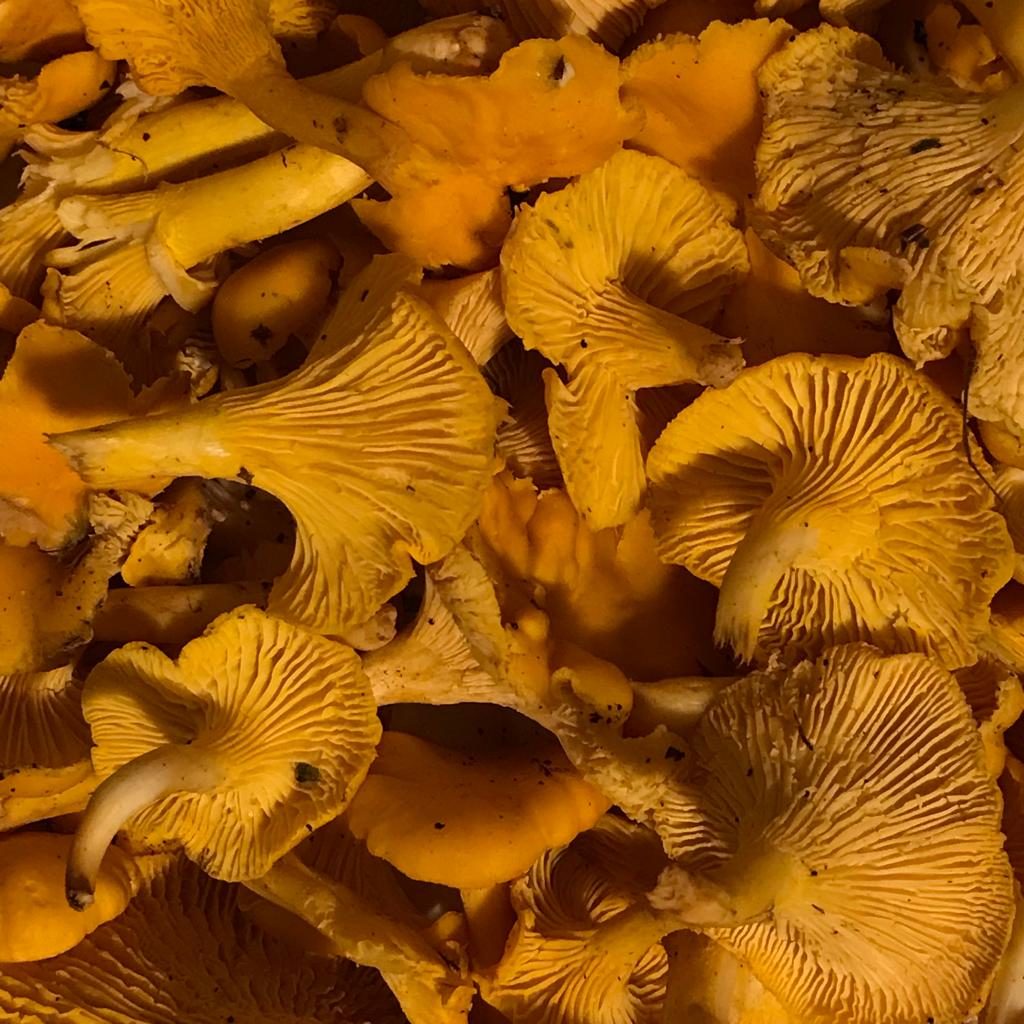Under cover of pine, Anna Fleming hunts for end-of-season chanterelles.
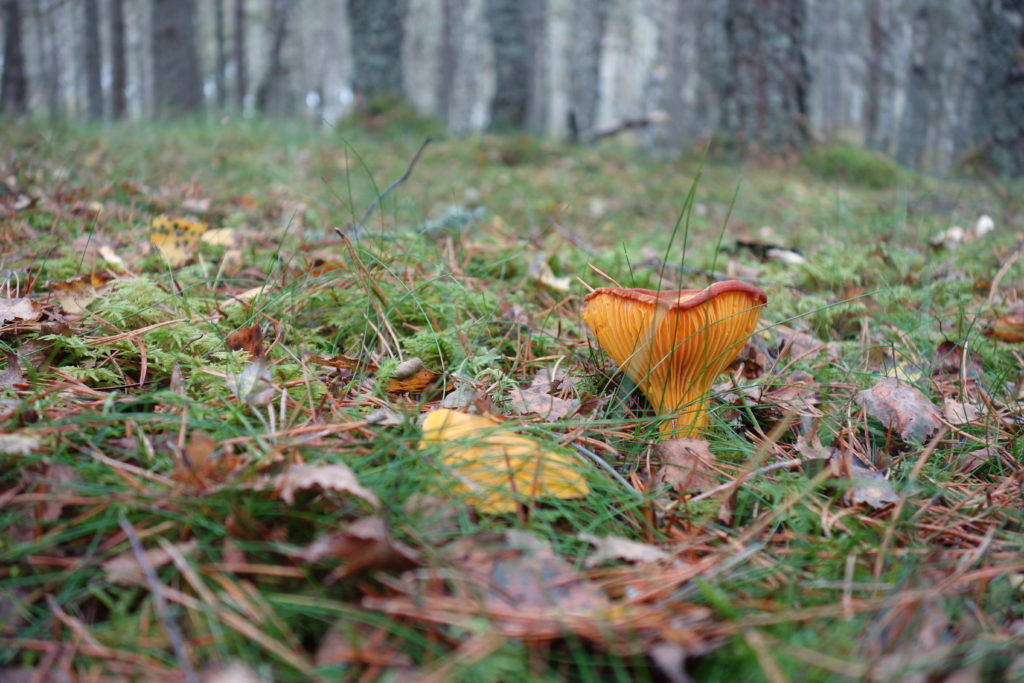
Heading into the pine forest, the mind wanders, flitting like a restless bird, hopping from this thing to that, taking it all in. The canopy is unsettled, pine needles brushing against one another. Some of the trees creak under the strain of the wind. Hairy green trails of lichen tumble down the tree trunks and through a gap in the wood a flash of colour reveals a sycamore blushing over the washing line.
Now to settle and tune in, bringing the focus to bear on this particular patch of forest. Eyes scour the floor, scanning the moss, lichen, grit and leaf litter, hunting for a certain golden-orange glow. It is late in the season but there are still some chanterelles to be had.
Chanterelles are a new mushroom for me. They were not part of my youthful lexicon. Where I grew up we did not have the quality of woodland to sustain these golden delicacies. We headed out onto the sheep-munched plains to gather our mushrooms.
There! – my dad might point – and my little legs would set off running across the grassy expanse, slipping in sheep muck, possibly toppling over a barbed wire fence or two to reach the luminous white dome. There was a thrill in the chase and then enquiry upon arrival. Some of the field mushrooms were clearly ruined. Knocked over by sheep, the mummified remains lay shrivelled on the ground. Those that were still standing were lifted from the ground and checked for pin prick holes where maggots might squirm and writhe inside the fungal flesh. The freshest field mushrooms were still pale underneath; the older ones had darkened and gave off a strong earthy scent.
Later, I returned to these same fields, and others like them, scouting for another treasure. These mushrooms had delicate wavy stalks and ochre-coloured caps, rising to a point like fairy hats or nipples. This gathering took a slower pace. There was no sprinting across the field – instead, like monks we walked slowly, meditatively, fingers clasped behind our backs, necks bent and eyes downcast, a couple of pilgrims among the many hundreds who came to the Black Mountains every autumn, hunting for Liberty Caps.
With such a history of mushrooming in the open fields, it feels strange to be heading into the woods to seek my autumn treats. And indeed, it was a professional, a colleague ecologist who taught me to identify the chanterelle. My own parents could not pass that knowledge on. The sense of estrangement that I feel as I wander into this northern forest looking for my new earthy acquaintance, the chanterelle, is perhaps less an individual quirk; rather, a reflection of a collective cultural estrangement. To my Czech, Latvian and Polish friends, there is nothing strange about mushroom-gathering in the forest. In fact, they are bemused by us Brits. Why don’t more of us go foraging in the forest? How to explain the centuries of exclusion, trespassing laws and deforestation that has unpicked so many of our cultural and ecological ties to the forest?
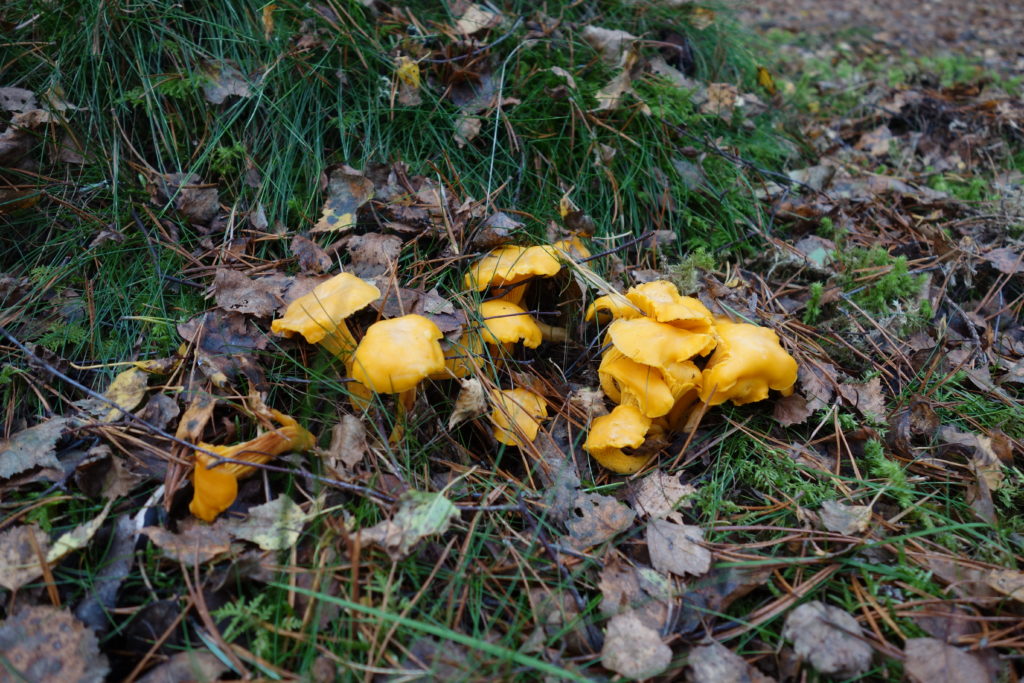
Leaving the path, I crunch through twigs, moss and birch leaves, chasing flashes of gold in the undergrowth. Odd chanterelles appear along the way, clustered in twos or threes, but then, further in, I come across little assemblies. Here, between the trees, are five, ten, twenty, forty or more golden-orange chanterelles. I kneel down and start to make sense of the company.
The poem ‘Mushrooms’ by Sylvia Plath springs to mind. (A poem I once shared with a group of people, gathered around a table beneath a strip light in a reading group somewhere in Merseyside.) Plath’s poem is written from within a fungal-fellowship, voiced from the perspective of the mushrooms. Through her imagining, we hear the mushrooms emerge from the ground, ‘very whitely, discreetly, very quietly’. They are furtive but powerful. Soon, there are, ‘So many of us! So many of us!’
Nudgers and shovers
In spite of ourselves.
Our kind multiplies:
We shall by morning
Inherit the earth.
Our foot’s in the door.
The power of the mushroom cannot be understated. My grandparents’ tarmac was once ruptured by a mushroom that forced its way up from beneath, emerging white and pristine.
I examine the chanterelle clan before me. Many are passing over. The caps are curling at the edges and turning brown. Some are swollen and grey with decay. However, a number still wear the sheen of active life, freshly pushed up from the ground. Squatting down, I slide my fingers beneath a golden cup – it is cool and damp to the touch – and pull, gently. The chanterelles come out easily and I turn them over, inspecting the underside. The gills run like neat defined veins, breaking into lacy patterns, outwards from the stem. I remove spiders, brush off pine needles, strands of moss and birch leaves before placing them in my bag.
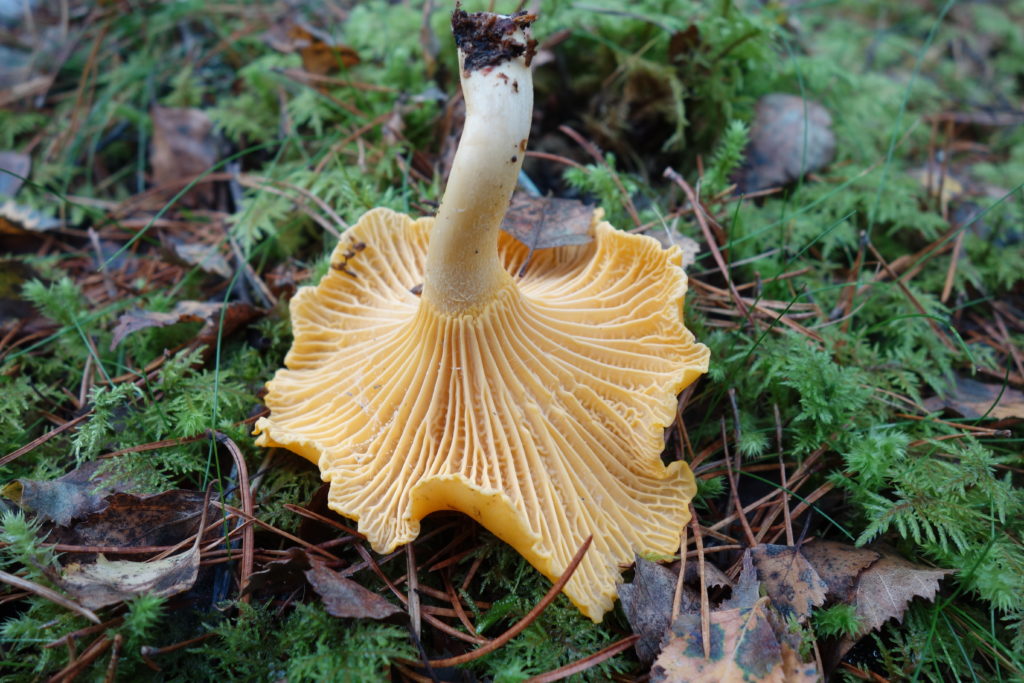
As my bag slowly fills and becomes heavy, my thoughts drift across the Atlantic to Robin Wall Kimmerer and her loving descriptions of plants in Braiding Sweetgrass. From strawberries to pecans, maples and sweetgrass, many chapters in her book centre on tender encounters with particular plants in America. Her knowledge is scientific, indigenous and informed by the experience of being both a mother and a daughter. Her weaving of science, culture and family, shows how bonds of connection and understanding build and flow, forming a rich web. She sees plants as gifts from the earth.
Within all her storying of plants and people, as I roam alone chanterelle-picking in the forest, two of her anecdotes come to mind. The first is her father’s ritual of pouring the top of the coffee pot away, giving the first hit to the earth in a ceremonial offering of thanks. That story reminds me, as I pick, to take pleasure in the seasonal ritual of gathering and also to leave plenty behind. To think of the earth and all its inhabitants and thus not to pick to exhaustion, but to stop once I have enough.
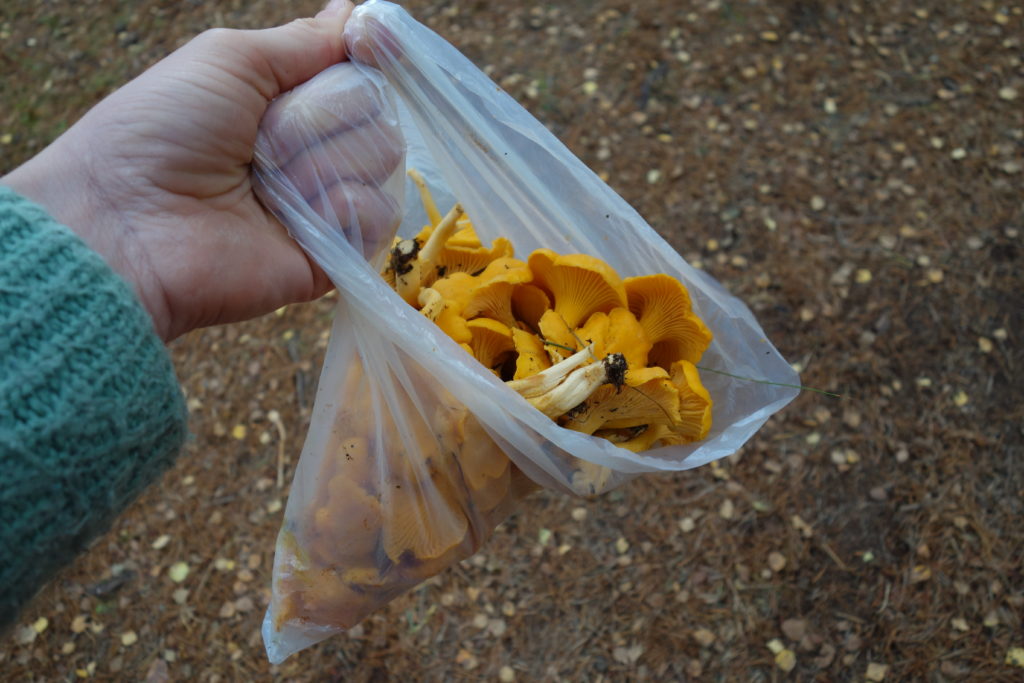
The other story, which may not have been a story at all, but more a thread within the book, part of the tone and texture of her storying, is to pick, even when out alone, with someone else in mind. Throughout the book, her daughters are present. Even when she is not with them and not describing them, they are somehow there, in everything she writes – her girls are integral to the way that she sees, approaches and moves through this world. I am not a mother, but similarly, a web of social associations informs my picking and Robin Wall Kimmerer reminds me to appreciate and celebrate the many relationships that are part of mushrooming.
When I was little and those short legs went sprinting across the fields, I never picked for my own stomach. I didn’t like mushrooms. My dad was the mushroom-eater. The black sludge that emerged from the sizzling frying pan delighted him. My joy came from picking them for him.
I was rather more partial to the liberty caps, but these were also always picked with others in mind. During the painstaking collecting out on the hills, pleasure tingled at the prospect of sharing this seasonal bounty with my crew. That little bag of magic mushrooms would take us off somewhere on a giggling evening adventure. For a few hours, these fungi would free our minds, setting the colours and patterns of this earth dancing; everything, briefly, illuminated.
The chanterelles find their place in a different set of connections. I will take them home and dig out a cookery book, leaf through and find the recipe that calls for butter, garlic, salt and pepper. The recipe is so simple, I hardly need to follow it, but taking that book down from the shelf and opening its pages awakens another set of associations. The book belonged to my grandmother and was passed down to me by my mother. Handling it, I feel my place within the entangled family life. Finally, when these mushrooms make their way out of the pan and onto the plate, to be shared with my flatmate, they will perform their last magic trick. By halving them, pleasure is doubled.
